Delphinus constellation is located in the northern sky. Its name means “dolphin” in Latin. In Greek mythology, the constellation represents the dolphin sent by the sea god Poseidon to find Amphitrite, the Nereid he wanted to marry. It is also associated with the story of Arion, the Greek poet and musician whose life was saved by dolphins at sea.
Delphinus is one of the smallest constellations in the sky. It is one of the Greek constellations, first catalogued by the Greek astronomer Ptolemy of Alexandria in the 2nd century CE.
Delphinus is recognizable for the diamond-shaped pattern formed by its brightest stars, known as Job’s Coffin, which outlines the body of the celestial Dolphin. The constellation is home to several interesting deep sky objects: the globular clusters NGC 6934 and NGC 7006, and the planetary nebulae NGC 6891 and NGC 6905 (the Blue Flash Nebula).
Facts, location & map
Delphinus is the 69th constellation in size, occupying an area of 189 square degrees. It lies in the fourth quadrant of the northern hemisphere (NQ4) and can be seen at latitudes between +90° and -70°. The neighboring constellations are Aquarius, Aquila, Equuleus, Pegasus, Sagitta, and Vulpecula.
The constellation name Delphinus is pronounced /dɛlˈfaɪnəs/. In English, the constellation is known as the Dolphin. The genitive form of Delphinus, used in star names, is Delphini pronunciation: /dɛlˈfaɪnaɪ/). The three-letter abbreviation, adopted by the International Astronomical Union (IAU) in 1922, is Del.
Delphinus belongs to the Heavenly Waters family of constellations, along with Carina, Columba, Equuleus, Eridanus, Piscis Austrinus, Puppis, Pyxis, and Vela.
Delphinus has five stars with known planets and contains no Messier objects. The brightest star in the constellation is Rotanev, Beta Delphini, with an apparent magnitude of 3.617. There are no meteor showers associated with the constellation.
Delphinus contains five formally named stars. The star names approved by the International Astronomical Union (IAU) are Aldulfin (Epsilon Delphini), Musica (18 Delphini), Rotanev (Beta Delphini A), Shama (HAT-P-23), and Sualocin (Alpha Delphini Aa).
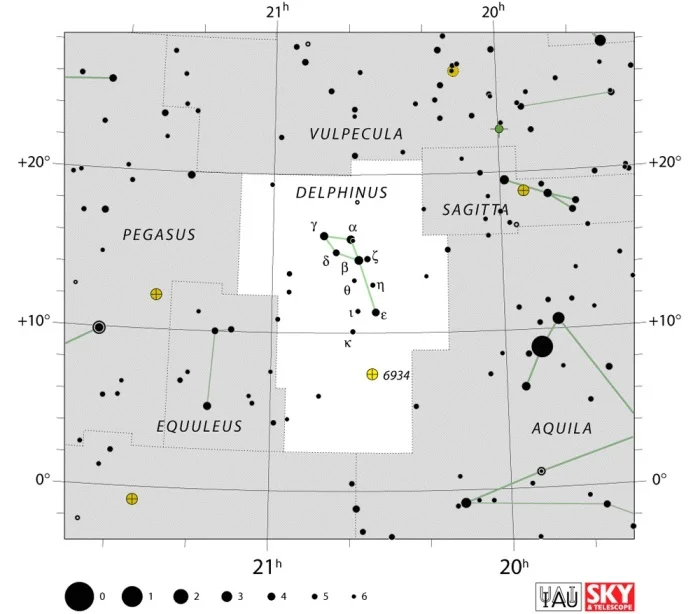
Delphinus constellation map by IAU and Sky&Telescope magazine
How to find Delphinus
Delpinus is easy to find because its brightest stars form a distinct asterism that represents the celestial dolphin. Alpha (Sualocin), Beta (Rotanev), Gamma and Delta Delphini form the dolphin’s body and Aldulfin (Epsilon Delphini) marks the tail. The diamond-shaped asterism representing the dolphin’s body is also known as Job’s Coffin.
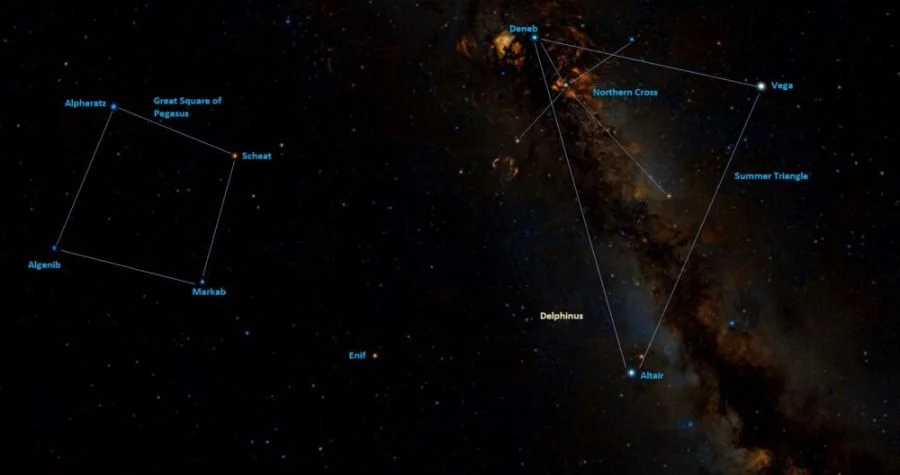
Location of Delphinus, image: Wikisky
The constellation Delphinus lies in the region of the sky between the bright Altair in the constellation Aquila and the Great Square of Pegasus. Aldulfin can be found by extending a line from Vega, one of the three bright stars that form the Summer Triangle, through Albireo, the star at the base of the Northern Cross (or at the beak of the Swan) in Cygnus. The stars of the Summer Triangle are easy to distinguish because Deneb also marks the top of the Northern Cross, Altair is flanked by the relatively bright Alshain and Tarazed, and Vega is part of Lyra‘s lyre-shaped pattern (similar to that of Delphinus, but slightly larger).
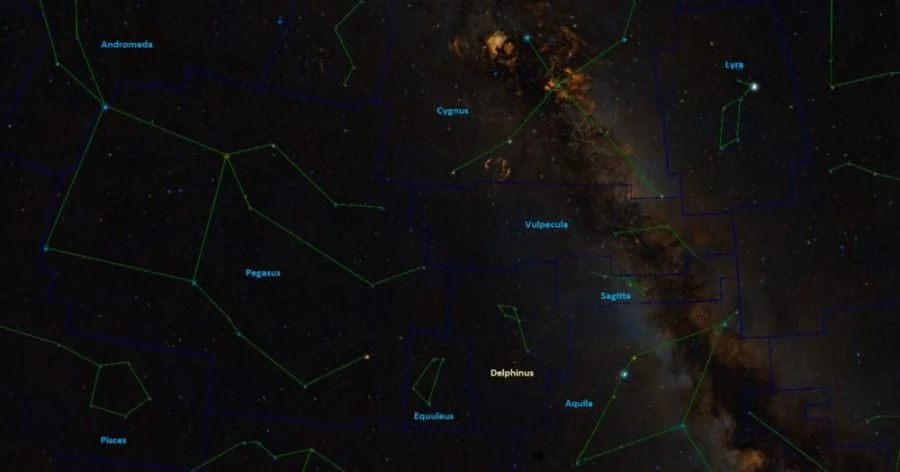
Delphinus location, image: Wikisky
Delphinus myth
There are two myths associated with the constellation Delphinus. In one, the dolphin constellation represents Poseidon’s messenger. When the sea god courted the nymph Amphitrite, one of the Nereids, she resisted his advances and took refuge among her sisters. Poseidon sent messengers to find her and bring her to him, among them a dolphin. The dolphin found the nymph, soothed her and brought her back to the god. The two were later married. Poseidon decided to honour the dolphin and placed his image among the stars.
In the other myth, it was Apollo, the god of poetry and music, who placed the dolphin among the constellations for saving the life of Arion, a poet and musician born on the island of Lesbos, whose skill with the lyre made him famous in the 7th century BC.
Arion was sailing back to Greece after a concert tour of southern Italy when the sailors who were also on the ship started plotting to take the money he had earned. Surrounded, Arion asked them to let him sing one last song. The sailors allowed this, and Arion’s music drew several dolphins to the ship. As he played, the dolphins swam alongside the ship and Arion decided to take a leap of faith and he jumped overboard.
One of the dolphins saved him and carried him all the way back to Greece. In this version of the myth, Apollo placed the dolphin next to the constellation Lyra in the sky, and Lyra represents Arion’s lyre.
The constellation Delphinus was also sometimes referred to as Job’s Coffin because of its long, box-like shape. Mostly, the name was restricted to the asterism formed by Alpha, Beta, Gamma and Delta Delphini.
Major stars in Delphinus
Rotanev – β Delphini (Beta Delphini)
Beta Delphini is the brightest star in Delphinus. It has an apparent magnitude of 3.617 and lies at a distance of 101 light years from Earth. The star’s traditional name, Rotanev, was given to it by the Italian astronomer Niccolò Cacciatore (1770 – 1841). Rotanev spelled backwards is Venator, which is the Latinized version of Cacciatore’s family name, which means “hunter.”
Beta Delphini was discovered to be a binary star in 1873 by the American astronomer S. W. Burnham. The star system is about 1.79 billion years old and it consists of a pair of white stars of the spectral types F5 III and F5 IV, a giant and a subgiant. The stars appear as a single point of light to the unaided eye. They orbit each other with a period of 26.66 years. They are separated by only 0.44 arcseconds, which makes them difficult to resolve in a telescope.
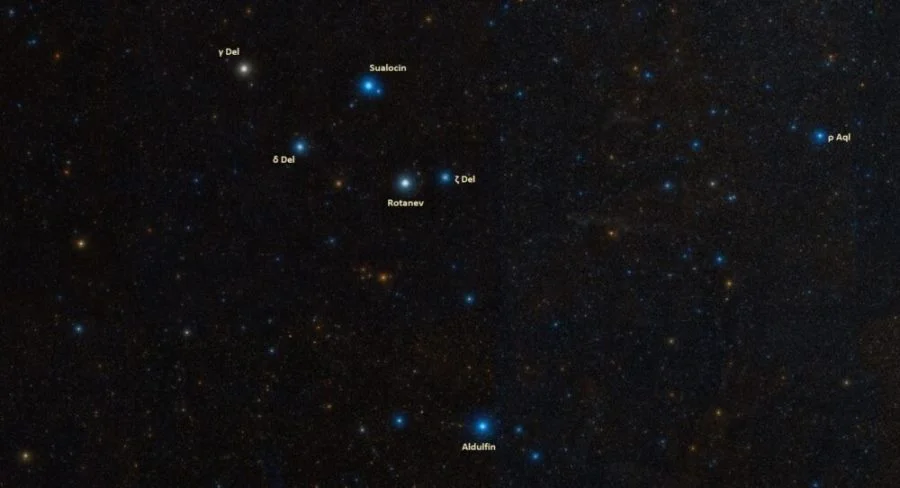
Delphinus stars, image: Wikisky
Sualocin – α Delphini (Alpha Delphini)
Alpha Delphini is the second brightest star in the constellation. It has a combined apparent magnitude of 3.777 and lies at a distance of 254 light years from Earth. It is a multiple star consisting of a physical pair, designated Alpha Delphini A, and five fainter stars, designated Alpha Delphini B, C, D, E, and F, which are likely optical companions.
The main pair form a spectroscopic binary star. The two components are separated by only 0.2 arcseconds and can only be resolved interferometrically. They orbit each other with a period of 17 years.
The primary component, Alpha Delphini Aa, has the stellar classification B9IV, indicating a blue-white subgiant star. The star has a mass of 2.82 solar masses and a radius 3.92 times that of the Sun. Its estimated age is about 227 million years. The properties of the companion, Alpha Delphini Ab, are difficult to determine because it is considerably fainter and too close to the brighter primary.
Alpha Delphini Aa is formally named Sualocin. Like Rotanev, it gets its name from Niccolò Cacciatore. It is the Latinized version of his first name, Nicolaus, spelled backwards.
Aldulfin – ε Delphini (Epsilon Delphini)
Epsilon Delphini is a blue-white giant of the spectral type B6III. It has a visual magnitude of 4.03 and lies at distance of 330 light years. It is a suspected variable star. Its brightness has been observed to vary from magnitude 3.95 to 4.05. The star is 4.6 times larger than the Sun and about 676 times more luminous.
The star’s name, Aldulfin, comes from its traditional name, Deneb Dulfim, derived from the Arabic ðanab ad-dulfīn, meaning “the dolphin’s tail.” The name was translated into Latin as Cauda Delphini.
γ Delphini (Gamma Delphini)
Gamma Delphini is a binary star system composed of a white main sequence star of the spectral type F7V and an orange subgiant with the stellar classification K1IV. The system lies at a distance of 101 light years from Earth. The stars have apparent magnitudes of 5.14 and 4.27.
The components are separated by 10.22 arcseconds and orbit each other with a period of 3,249 years. The primary component, Gamma1 Delphini, has a mass 1.57 times that of the Sun and a radius 2.21 times solar. With an effective temperature of 6,303 K, it is 6.9 times more luminous than the Sun.
The companion, Gamma2 Delphini, is larger and more massive, with a size of 6.43 solar radii and a mass of 1.72 solar masses. With a surface temperature of 4,865 K, it shines with 20.8 solar luminosities.
A candidate planet orbiting the companion was announced in 1999, but it has not yet been confirmed. If it exists, the planet has a mass of at least 0.7 Jupiter masses and orbits the host star with a period of 1.44 years (525.6 days) from a distance of 1.5 astronomical units.
δ Delphini (Delta Delphini)
Delta Delphini is a spectroscopic binary star with a combined apparent magnitude of 4.43. It lies at a distance of 223 light years from the Sun.
The two components orbit each other with a period of 40.605 days. They have a combined spectral class of kA7hF0mF0(IV-V), indicating a white star that is coming to an end of its main sequence lifetime. Both stars are classified as Delta Scuti variables, young pulsating stars whose brightness varies as they expand and contract. The system’s brightness varies from magnitude 4.38 to 4.49 over a dominant period of 0.1568 days.
ρ Aquilae (Rho Aquilae)
Rho Aquilae is a white main sequence dwarf of the spectral type A2V. The star is 19.5 times more luminous than the Sun. It has an apparent magnitude of 4.94 and lies at an approximate distance of 150 light years from Earth. Its estimated age is between 50 and 120 million years.
Rho Aquilae is known by its traditional name, Tso Ke, which means “left flag” in Mandarin. In Chinese astronomy, Left Flag is an asterism formed by Rho Aquilae and several stars in the constellation Sagitta. Rho Aquilae itself is known as the Ninth Star of Left Flag.
The star has the Bayer designation Rho Aquilae because it belonged to the constellation Aquila until 1992, when it moved across the border into Delphinus.
Musica (18 Delphini)
Musica is a yellow giant star with a mass 2.3 times that of the Sun and a radius 8.5 times solar. The star has an apparent magnitude of 5.506 and lies about 249 light years away. It is 40 times more luminous than the Sun.
18 Delphini has a confirmed exoplanet in its orbit. The discovery was announced on February 19, 2008. The planet has a mass at least 10.3 times that of Jupiter and orbits the star from a distance of 2.6 astronomical units with a period of about 993.3 days.
Both the planet and the star were named after a public nomination and vote in 2015. The winning names were submitted by the Tokushima Prefectural Jonan High School Science Club of Japan. They are associated with the ancient Greek musician and poet Arion, whose life was saved by dolphins at sea.
Shama (HD 99109)
Shama is an orange main sequence star of the spectral type K0V. With an apparent magnitude of 9.10, it is invisible to the unaided eye. It lies at a distance of about 160 light years.
The star is slightly less massive than the Sun, with 93% of the Sun’s mass, and it shines with 0.724 solar luminosities. With a metallicity 2.07 times that of the Sun, the star has an estimated age of more than 12.2 billion years.
A planet was confirmed to be orbiting Shama in 2006. The planet has a mass of at least 0.502 Jupiter masses and orbits the star from a distance of 1.105 astronomical units with a period of 439.3 days.
The planet, designated HD 99109 b, was given the proper name Perwana after the International Astronomical Union’s (IAU) NameExoWorlds campaign in 2019. The name means “moth” in Urdu. The host star was formally named Shama at the same time. Shama means “flame” or “small lamp.” Both names come from Pakistan.
Deep sky objects in Delphinus
NGC 6934 (Caldwell 47)
NGC 6934 is a relatively large globular cluster near the star Epsilon Delphini. It is approximately 52,000 light years distant and has a visual magnitude of 8.83. It occupies 8.4′ of the sky. The cluster was discovered by William Herschel on September 24, 1785.
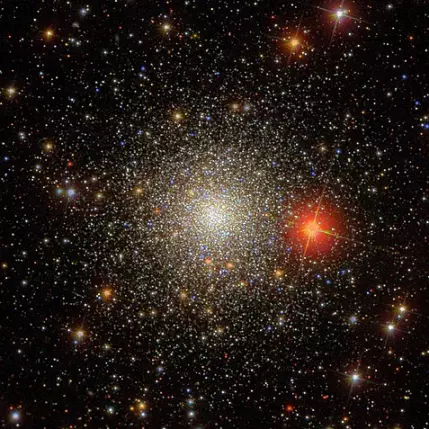
NGC 6934, image: Sloan Digital Sky Survey
NGC 6891
NGC 6891 is a small planetary nebula located near the star Rho Aquilae. It has an apparent size of 0.33′ by 0.3′. The nebula is about 7,200 light years distant from Earth. It was discovered by Scottish astronomer Ralph Copeland on 22 September, 1884.
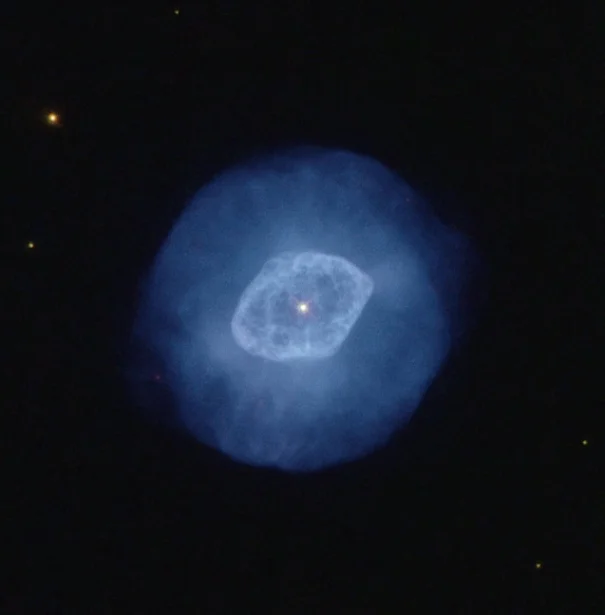
NGC 6891, image: Judy Schmidt
Blue Flash Nebula – NGC 6905
NGC 6905 is a small planetary nebula, bluish in colour. It can be observed in a six-inch telescope. It has an apparent magnitude of 10.9 and lies 7,500 light years away. It was discovered by William Herschel in 1784.
NGC 7006 (Caldwell 42)
NGC 7006 is a globular star cluster located approximately 137,000 light years away in the outskirts of the Milky Way. The cluster is part of the galactic halo, a region of the Milky Way spherical in shape and consisting of gas, dark matter and the occasional star cluster.
NGC 7006 has a visual magnitude of 10.6 and occupies 2.8′ of the apparent sky. It appears close to the star Gamma Delphini.
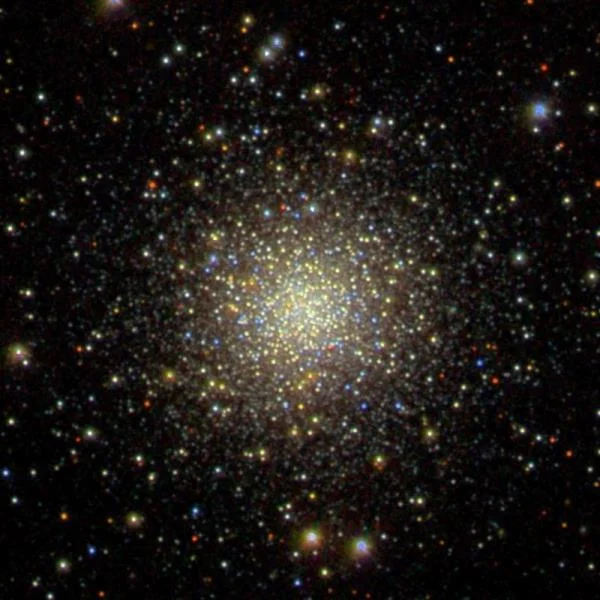
NGC 7006, image: Sloan Digital Sky Survey
NGC 7025
The spiral galaxy NGC 7025 has an apparent magnitude of 13.71 and lies over 207 million light years away. It is classified as a LINER galaxy. It spans 161,830 light years in diameter.
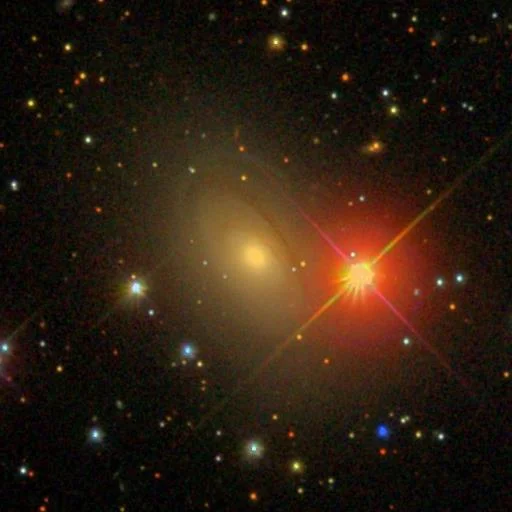
NGC 7025, image: Sloan Digital Sky Survey
NGC 7003
NGC 7003 is another spiral galaxy. It has a visual magnitude of 13.76 and an estimated diameter of 80,800 light years. The galaxy lies about 222 million light years from Earth. It hosted a Type II supernova, designated SN 2011dk, first observed on May 12, 2011.
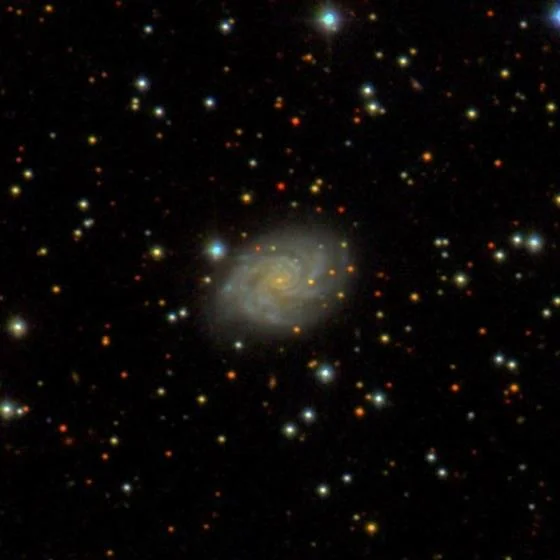
NGC 7003, image: Sloan Digital Sky Survey